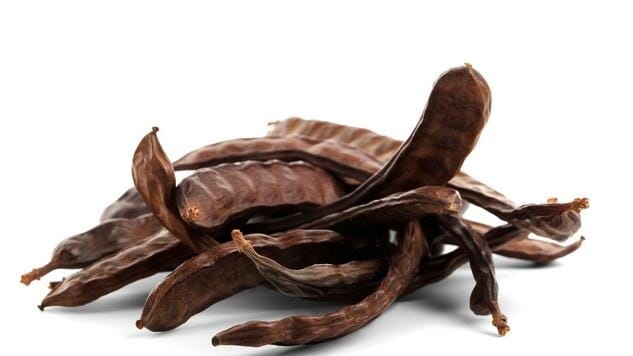Second Look: Carob

If you’re like me, you remember growing up in the 1970s with the taste of carob as part of your flavor memory. It was rather commonplace, touted as “healthy” and embraced as part of the vegetarian, hippy eating philosophy. I asked my mother why she fed us carob in the ‘70s and she replied, “Well, we changed our diet, tried to eat healthier, less meat, and carob was part of that whole thing.” Not everyone was willing to eat it, and you’ll hear people today say how much they hated it. However, I loved it and still do, and am happy to say it’s starting to experience a bit of a comeback, while its traditional uses are still going strong.
Here in the US, carob is most often referred to as a “chocolate substitute.” You’d find carob chips as a topping for frozen yogurt and also in trail mix; carob coverture enrobed raisins and almonds are still available at many health food stores. As far as its nutrition, it is rich in phosphorous, calcium, and essential minerals. It’s also vegan, caffeine-free and gluten-free, and naturally sweet, eliminating to need to fortify it with sugar, though sugar was often added. Unfortunately, along with that, hydrogenated vegetable oils were often added to carob candy, neutralizing its inherent health benefits. That’s changing, though; more on that later in the story.
Carob is an ancient food, found in the greater Mediterranean region, in parts of South America, and Southern California. The carob tree is an evergreen, and drought tolerant (thought rain is necessary for it to fruit). Its pods contain legumes, but the entire thing – pod, beans and all – is used as food (both for humans and animals).
It is also plays a part in the world’s major faiths. It’s mentioned in the Talmud – a basket of carob pods alone nourished the impoverished Rabbi Hanina ben Dosa from Sabbath eve to Sabbath eve. (Ta’anit, 24b), and Jews eat it during Tu Bishvat (a celebration of the trees). In Islam, carob juice is consumed during Ramadan. The conventional interpretation of a section in the Book of Matthew, is John the Baptist ate carob in the desert – “locusts” may very well mean carob beans, the fruit of the Locust Tree; it is sometimes referred to as St. John’s Bread. In any case, carob trees are one of the most common in Israel.
Carob is also a prominent crop in northern Cyprus, and it was one of the largest exporters of carob up until the1960s. On the Mediterranean islands of Malta and Gozo, carob is used to make a syrup for both medicinal and food purposes. On that topic, I spoke with my neighbor Mary Ann, who lived on Malta for 25 years. Each year she would make this syrup from local carob pods, and used it as a sore throat medicine, as part of a hot toddy, and simply warmed in milk. “It’s an ancient remedy for coughing,” she says. “We had a huge carob tree in front of our house, across the street. I used to go and collect the carobs when they got ripe and fell off the tree. I would cook them up, put them in a huge pot and boil them until they got soft and mushy, and all the juice would come out of them. Then I would mash them as hard as I could, and then strain the mixture, and take the water thick with this carob mush, I’d add sugar, lemon, tangerine, orange juice, cinnamon, nutmeg, clove, and cook it until everything becomes a thick syrup. Then I’d strain it again and add a bottle of brandy. I’d make like six whiskey bottles full of this and have it for the whole winter! It’s very good with hot milk, too.”
-

-

-

-

-

-

-

-

-

-

-

-

-

-

-

-

-

-

-

-

-

-

-

-

-

-

-

-

-

-

-

-

-

-

-

-

-

-

-

-








































